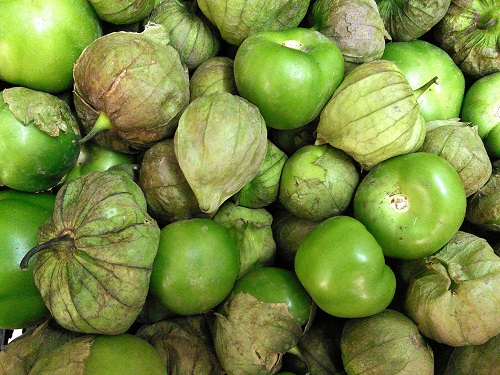Food Facts Friday: Tomatillos

When grocery shopping, have you ever noticed a small round produce that’s covered by a paper-like wrapper? I’m not talking about an onion, which is wrapped in a brown skin-like wrapper. The produce I’m referring to is about the size of a golf ball or slightly larger, and has what looks like a small green tomato inside a green to greenish-brown husk. If you’ve seen this produce, it’s called a tomatillo.
Tomatillo facts
Tomatillos belong in the same family as tomatoes. Just like their tomato cousins, tomatillos can be green, yellow, red or purple. Maturity level at harvest determines their color. Tomatillos are a summer produce and are most commonly harvested when they are green and under ripe. This is what adds tartness to salsa verde in Mexican cuisine.
Cooking with tomatillos
Smaller tomatillos are commonly sweeter, while larger ones are tart. Raw tomatillos add a citrusy flavor to a dish. When broiled until their skins are somewhat charred, (about 5 minutes per side) tomatillos add a smoky flavor. When broiling, make sure the oven is preheated and at temperature before putting your tomatillos in or you’ll end up with mush.
To choose tomatillos, look for husks that are tightly fitted to the tomatillo, without blemishes. Look for green to greenish-brown husks; the husks brown as they age. Husks that are shriveled are a sign that the tomatillo is old. The tomatillo should be firm, not mushy.
Tips for removing the husks
To eat a tomatillo, peel the husk off first. Beware, when removing the husk, there is a sticky film left on the skin of the tomatillo. Simply wash it off under cold running water. Another way to remove the husk is to submerge the tomatillo in a bowl of water for five minutes, which dissolves the sticky film and allows the husk to peel off easily.
Nutrition Facts
The DaVita Food Analyzer is a quick and easy tool to use to see how a food item fits into a kidney-friendly diet. Using the DaVita Food Analyzer, let’s see how the tomatillo compares to its cousins, the red and green tomatoes:
| Nutrients | Tomatillo, raw 100 gm / 1/2 cup chopped | Tomato, green, raw 100 gm/ 1/2 cup chopped | Tomato, red, raw 100 gm / 1/2 cup chopped |
| Calories | 32 / 21 | 23 / 21 | 18 / 21 |
| Protein (gm) | 1 | 1 | 1 |
| Sodium (mg) | 1 | 12 | 5 |
| Potassium (mg) | 268 / 177 | 204 / 184 | 237 / 213 |
| Phosphorus (mg) | 39 / 26 | 28 / 25 | 24 / 22 |
Try this kidney-friendly Salsa Verde recipe to use in making enchiladas or serve with eggs, tacos or your favorite Mexican dish.
Speak with your renal dietitian to see how you may include tomatillos in your kidney-friendly diet. Since tomatillos are high in potassium like tomatoes, your renal dietitian may adjust your portion size and frequency so you may enjoy them.
Additional Kidney Diet Resources
Visit DaVita.com and explore these diet and nutrition resources:
- DaVita Food Analyzer
- DaVita Dining Out Guides
- Today’s Kidney Diet Cookbooks
- DaVita Kidney-Friendly Recipes
- Diet and Nutrition Articles
- Diet and Nutrition Videos
- Kidney Smart® Virtual Classes
This article is for informational purposes only and is not a substitute for medical advice or treatment. Consult your physician and dietitian regarding your specific diagnosis, treatment, diet and health questions.

Recent Comments